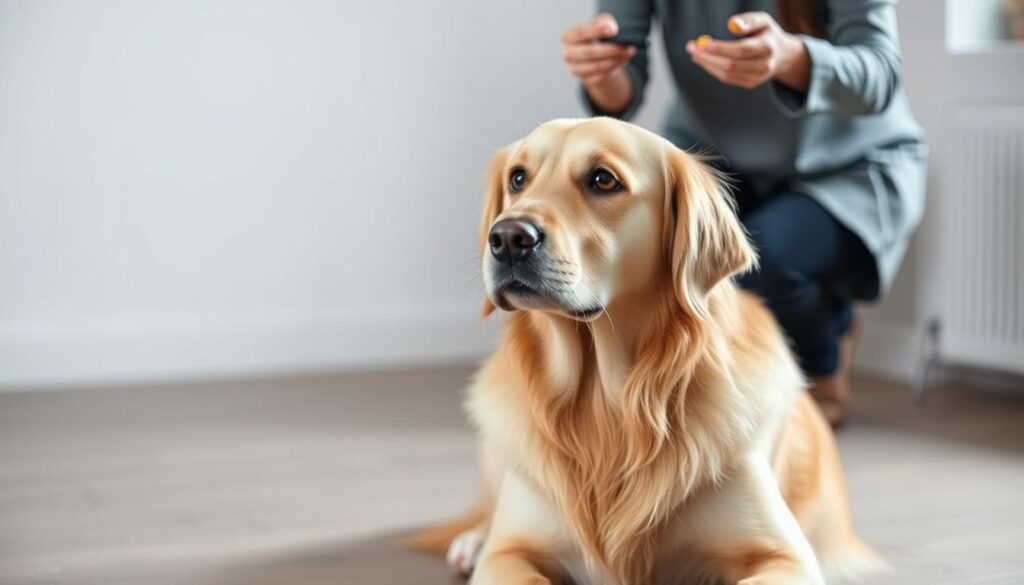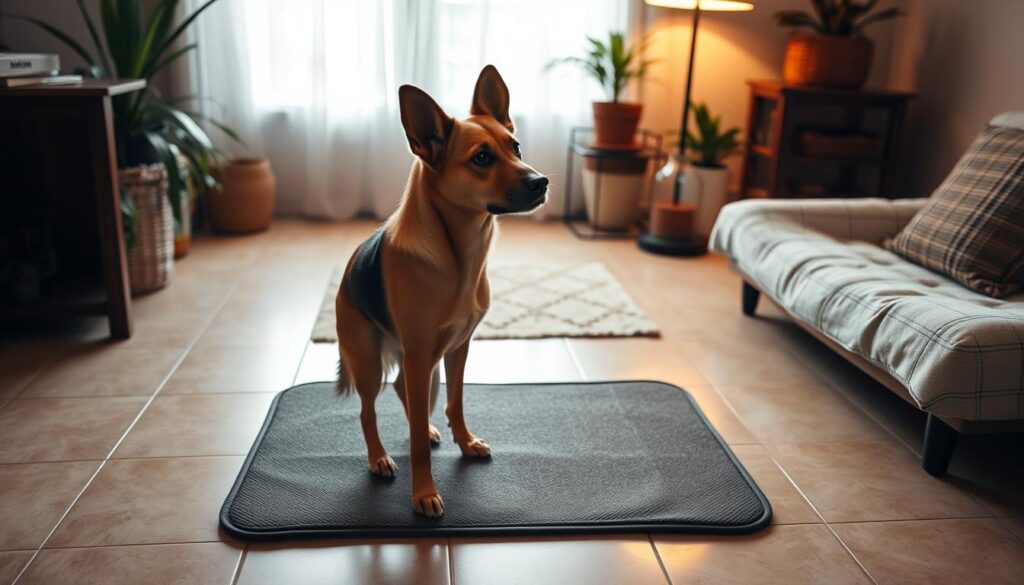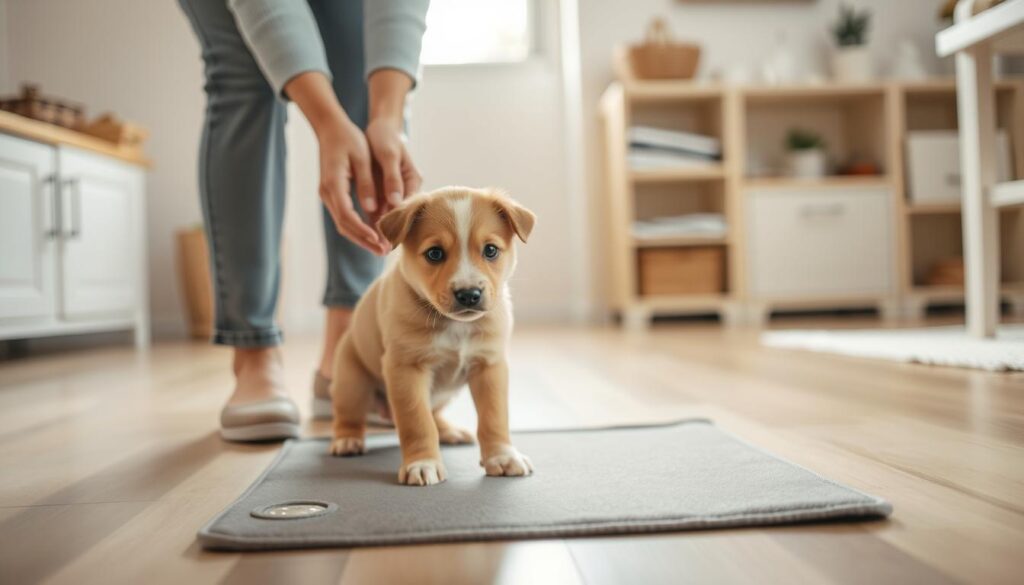If you’re a dog owner, you might be looking for ways to stop your dog from peeing inside. Housebreaking a puppy or an older dog takes patience, consistency, and the right strategy. Finding the best solution for your dog’s indoor urination is key.

Understanding why your dog pees inside and setting up a good house training plan can help a lot. By finding the best ways to solve this problem, you can give your dog the care they need. You’ll also keep your home clean and accident-free.
Key Takeaways
- Identify the underlying reasons for your dog’s indoor urination
- Develop a consistent house training schedule
- Use positive reinforcement techniques for effective dog training
- Choose the right rewards and timing for praise
- Consider crate training as a potential solution
- Be patient and persistent in your training approach
- Seek professional help if needed to address persistent issues
Understanding Why Dogs Urinate Indoors
Understanding why dogs pee inside is key to indoor potty training for dogs. They pee inside for many reasons, like health issues, behavioral problems, age, and stress. Knowing the cause helps you find the best way to stop accidents.
Here are some things to think about:
- Medical issues, such as urinary tract infections or kidney stones, which can cause dogs to urinate indoors
- Behavioral problems, like separation anxiety or lack of training, which can lead to indoor accidents
- Age-related factors, such as declining bladder control, which can contribute to indoor urination
- Anxiety and stress triggers, like changes in the environment, which can also lead to indoor accidents
By understanding these factors, you can create a targeted plan for indoor potty training for dogs. This will help prevent accidents and stop them from happening inside. Every dog is different, so what works for one might not work for another. With patience, consistency, and the right approach, you can help your dog overcome indoor urination issues and achieve successful indoor potty training for dogs.

Creating an Effective House Training Schedule
Consistency is crucial when housebreaking a puppy. A routine for feeding, exercise, and potty breaks helps your dog learn. By always taking them to the same spot, they learn to go outside.
Here are some dog training tips for a house training schedule:
- Take your dog outside right after meals and naps
- Use a consistent command, like “go potty,” to link the command with the action
- Praise and reward your dog for successful potty breaks
Teaching dogs to go outside needs patience and consistency. Follow these dog training tips and set a routine. Always praise and reward your dog for good behavior. If you’re struggling, don’t hesitate to get professional help.

| Time of Day | Activity | Frequency |
|---|---|---|
| 7:00 am | Feeding and potty break | Once |
| 12:00 pm | Exercise and potty break | Once |
| 5:00 pm | Feeding and potty break | Once |
The Role of Positive Reinforcement in Potty Training
Positive reinforcement is key in potty training. It rewards good behavior, helping your dog learn faster. This method is great for stopping dog accidents inside by linking going outside with good things.
To use positive reinforcement, pick the right rewards for your dog. Treats, praise, or playtime work well. Make sure the rewards are exciting and meaningful for your dog. Also, being consistent is crucial. It helps your dog know what’s expected.
Crate training for dogs can also help with potty training. It gives a safe space for your dog to learn.
- Be consistent with rewards and praise
- Use high-value rewards for good behavior
- Gradually phase out rewards as your dog becomes more reliable
By following these tips, you can help your dog learn faster. Always be patient and consistent. Rewarding good behavior encourages positive results.
Setting Up a Designated Outdoor Potty Area
For indoor potty training for dogs, having a special outdoor potty spot is key. This spot should be easy to get to and close to your back door. It helps your dog learn to go there for potty breaks.
To make a good outdoor potty area, here are some dog training tips:
- Choose a quiet and private area to minimize distractions
- Make sure the area is clean and free of debris
- Use positive reinforcement, such as treats and praise, to encourage your dog to use the designated area
By following these tips and setting up a designated outdoor potty area, you can help prevent indoor accidents. Always watch your dog during potty breaks. This ensures they learn to use the area correctly.
With patience, consistency, and the right dog training tips, you can teach your dog to go potty outside. This makes preventing indoor accidents a main goal in your indoor potty training for dogs journey.
What is the Best Way to Stop My Dog from Urinating Indoors Through Crate Training
Crate training is a great way to stop dog accidents inside. It gives your dog a safe, comfy space. This helps them learn to hold their bladder and bowels. It’s especially helpful when housebreaking a puppy.
To start, pick the right crate size for your dog.
Selecting the Right Crate Size
A crate that’s too small is uncomfortable. One that’s too big can lead to accidents. The perfect size lets your dog stand, turn, and lie down easily.
Here’s how to choose the right size:
- Measure your dog’s length and height for the minimum size.
- Think about your dog’s breed and size for the best fit.
- Pick a crate that’s sturdy and comfy.
Establishing a Crate Schedule
Setting a crate schedule is key. Start with short times, like 1-2 hours. As your dog gets used to it, you can increase the time.
Always take your dog outside right after crate time. This helps them learn good habits and prevents accidents.
By following these tips, crate training can help stop dog accidents inside. It makes housebreaking a puppy easier. With patience, consistency, and positive reinforcement, your dog will learn to control their bladder and bowels.
Environmental Modifications to Prevent Accidents
Environmental changes are key in preventing indoor accidents. By removing food and trash, you can keep your dog focused. This is crucial for indoor potty training for dogs. It makes your home safer and helps your dog learn better.
Here are some dog training tips for making your home safer:
- Block off areas of the house to prevent accidents
- Remove items that might distract your dog, like shoes or toys
- Create a special potty area indoors and outdoors
These changes can help avoid accidents and make training easier. Always be patient and consistent. Reward your dog with praise and treats for good behavior.
Addressing Special Circumstances and Challenges
Every dog is different when it comes to housebreaking a puppy. Some may need special care and challenges to overcome. If you’re trying to stop dog accidents inside, think about what your dog needs. For example, older dogs might need more patience and gentleness because of their age or health issues.
Managing multiple dogs can also be tough. Each dog has its own needs and personality. You might need to use puppy pads or indoor potty systems if you live in a small space. Knowing these special needs helps you make a plan to stop dog accidents inside.
Training Older Dogs
- Be patient and gentle when introducing new dog training tips
- Consider any existing medical issues or habits
- Use positive reinforcement to encourage good behavior
Managing Multiple Dogs
- Develop a schedule that meets the needs of each dog
- Use separate areas for each dog to reduce competition and stress
- Provide individual attention and training to each dog
Apartment Living Solutions
- Use puppy pads or indoor potty systems
- Create a designated potty area
- Take your dog outside frequently to prevent accidents
By tackling these special needs, you can create a solid plan for housebreaking a puppy and stopping dog accidents inside. This ensures a happy and healthy bond with your dog.
Common Training Mistakes to Avoid
When training your dog to use the potty, it’s key to know common mistakes. These can slow down the learning process. By steering clear of these errors, you can make potty training a positive experience for your dog. This is done by using positive reinforcement training to encourage good habits. The main aim is to prevent indoor accidents and stop dog accidents inside by setting a regular routine and rewarding good behavior.
Don’t punish your dog for accidents. This can make them associate potty training with negative feelings. Instead, focus on preventing indoor accidents by setting a consistent schedule. Give your dog regular chances to go outside. A consistent routine helps your dog learn faster, so it’s important to stick to it and reward them when they go outside.
Using the wrong cleaning methods can also lead to more accidents. This is because the smell can attract your dog to the same spot again. Use a cleaner that gets rid of odors, and avoid ammonia-based cleaners. By knowing these common mistakes and avoiding them, you can make potty training a positive experience for your dog. This is done by using positive reinforcement training to encourage good behavior and preventing indoor accidents.
Conclusion: Maintaining Long-Term Success in Indoor Potty Training
To keep your dog’s indoor potty training on track, you need to stay committed and patient. Use the tips from this guide to help your dog learn good habits. This way, you can avoid accidents in the future.
Every dog is different, so you might need to change your dog training tips sometimes. Keep an eye out for any issues, reward good behavior, and solve problems as they come up. With effort and time, you can make your home a happy, well-trained place for your dog.
Following the best ways to stop your dog from peeing inside will make your home better and your bond stronger. Enjoy the process and celebrate your dog’s progress. You’re on the right track to a happy, well-trained pet.
FAQ
What is the best way to stop my dog from urinating indoors?
To stop your dog from peeing inside, first understand why they do it. Create a routine for feeding, exercise, and potty breaks. Use positive rewards to encourage good behavior.
Set up a special potty area outside. Crate training can also help prevent accidents.
How can I understand why my dog is urinating indoors?
There are many reasons why your dog might pee inside. It could be a medical issue, a behavioral problem, or due to age or stress. Finding the cause is key to solving the problem.
Start by talking to a vet to check for any health issues.
What is the best way to create an effective house training schedule for my dog?
For a good house training schedule, have a set routine. Take your dog to the same spot each time. Praise and reward them when they go potty outside.
Keep a strict schedule. This helps your dog learn to hold it until it’s time to go outside.
How can positive reinforcement help with potty training my dog?
Positive reinforcement is a great way to train your dog. Use treats and praise to encourage good behavior. Choose the right rewards and be consistent in your training.
This approach helps your dog learn to go potty outside.
What is the best way to set up a designated outdoor potty area for my dog?
Creating a special potty area outside is crucial. It should be easy to get to and free from distractions. This helps your dog learn to go potty in one place.
How can crate training help stop my dog from urinating indoors?
Crate training can help prevent indoor accidents. Choose the right size crate and make it a positive space. This helps your dog learn to hold it until it’s time to go outside.
What environmental modifications can I make to prevent indoor accidents?
Changing your environment can help prevent accidents. Remove temptations and block off areas of the house. This makes it safer and less likely for your dog to have an accident.
How can I address special circumstances and challenges when potty training my dog?
Every dog is different, and some may need special care. This includes training older dogs or managing multiple dogs. Find solutions that fit your dog’s needs.
What common training mistakes should I avoid when potty training my dog?
Avoid using punishment and having inconsistent schedules. Punishment can be harmful, and inconsistent schedules confuse your dog. Also, avoid using the wrong cleaning methods.
